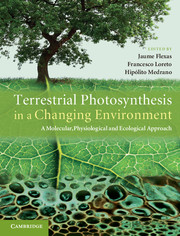 Terrestrial Photosynthesis in a Changing Environment
Terrestrial Photosynthesis in a Changing Environment Book contents
- Frontmatter
- Contents
- List of contributors
- Preface
- Acknowledgements
- List of abbreviations
- 1 Terrestrial photosynthesis in a changing environment
- Part I Photosynthesis
- Part II Measuring photosynthesis
- Part III Photosynthetic response to single environmental factors
- Part IV Photosynthesis in time
- Part V Photosynthesis in space
- Part VI Photosynthesis in a global context
- 33 Photosynthetic water-use efficiency
- 34 Global change and photosynthesis
- References
- Index
33 - Photosynthetic water-use efficiency
Published online by Cambridge University Press: 05 March 2013
- Frontmatter
- Contents
- List of contributors
- Preface
- Acknowledgements
- List of abbreviations
- 1 Terrestrial photosynthesis in a changing environment
- Part I Photosynthesis
- Part II Measuring photosynthesis
- Part III Photosynthetic response to single environmental factors
- Part IV Photosynthesis in time
- Part V Photosynthesis in space
- Part VI Photosynthesis in a global context
- 33 Photosynthetic water-use efficiency
- 34 Global change and photosynthesis
- References
- Index
Summary
Introduction
Gas exchange is tightly coupled to evaporation in all living organisms (Woods and Smith, 2010). Photosynthesis of terrestrial plants is associated with water loss because the CO2 needed to be fixed into carbohydrates enters the leaf through stomata with the consequent loss of water from the sub-stomatal cavity to the atmosphere. Leaf-to-air water-vapour gradient is about 100 times larger than the CO2 gradient. Consequently, plants have to tightly regulate stomatal opening in order to avoid leaf dehydration. This causes a wide variation of the ratio between the rate of CO2 uptake (photosynthesis) and the rate of water-vapour loss (transpiration). This ratio expresses the efficiency of the carbon gain with respect to water loss, i.e., water-use efficiency (WUE).
Plant growth and biomass production are thus largely conditioned by the water resources, which are extremely variable in time and space around the globe, therefore water availability along the growing season is a determinant factor for plant-biome distribution and GPP. In general, it is widely established that ecosystem or crop production is closely dependent on soil-water availability (Beer et al., 2007).
Figure 33.1 shows a list of the main biological determinants, related with plant photosynthesis and transpiration characteristics, as well as the main environmental conditions that determine the specific values of WUE and its wide range of variation.
- Type
- Chapter
- Information
- Terrestrial Photosynthesis in a Changing EnvironmentA Molecular, Physiological, and Ecological Approach, pp. 523 - 536Publisher: Cambridge University PressPrint publication year: 2012
- 2
- Cited by


